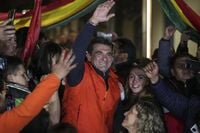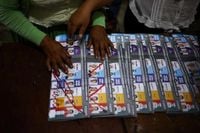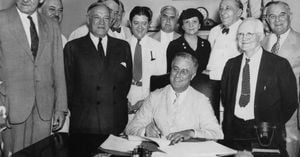Bolivia’s political landscape underwent a seismic shift on August 17, 2025, as voters brought an end to nearly two decades of leftist, indigenous-led rule by the Movement Towards Socialism (MAS) party. The general election, which many analysts had predicted would be contentious and possibly chaotic, instead delivered a clear message: the country is ready for change, both in government and in its broader political system.
The MAS party, once the unassailable force in Bolivian politics, suffered its worst defeat in a generation. Its official candidate, Eduardo del Castillo, garnered a mere 3 percent of the vote—a staggering collapse from the 55 percent the party achieved in the 2020 election, according to early official results reported by Reuters and The Irish Times. This dramatic downturn was fueled in part by years of internal strife, a faltering economic model, and a boycott campaign led by former president Evo Morales, who was barred from seeking another term by the courts.
The election results left MAS reduced to a shadow of its former self. Not only did the party lose its grip on the presidency, but it also appeared likely to be shut out of the powerful Senate and left with just a handful of seats in the lower house. In a symbolic blow, almost 22 percent of ballots were blank or spoiled, a sharp rise from the 5 percent recorded in the previous election. Many of these came from rural, indigenous regions—traditionally MAS strongholds—where Morales’ boycott call resonated most deeply.
Morales himself, once the charismatic face of the leftist movement in Bolivia, watched the results unfold from his political base in Chapare. Surrounded by armed supporters and facing serious legal charges, Morales declared he would not recognize the election’s outcome, insisting he was the target of a political witch-hunt. Still, his influence seemed to be waning, as the vote proceeded without major disruptions and with steady turnout, according to international observers cited by Reuters.
As the dust settled, the race for the presidency narrowed to two figures: centrist senator Rodrigo Paz and right-wing former president Jorge “Tuto” Quiroga. Paz, representing the Christian Democratic Party, led the field with just over 32 percent of the vote. The son of former president Jaime Paz Zamora, Rodrigo Paz had long been considered a political outsider; opinion polls had barely registered his campaign in the weeks leading up to the election. His surprise victory was attributed in part to his running mate, Edmand Lara—a former police officer turned social media personality known for his anti-corruption videos.
In his victory speech, Paz struck a tone of renewal and hope. “We are the voice of those who didn’t appear in the polls, of those who had no voice, the voice of a Bolivia that never had a voice and now has a voice,” he declared, as reported by The Irish Times. He also told crowds, “Bolivia is not just asking for a change in government, it’s asking for a change in the political system. This is the beginning of a great victory, of a great transformation,” according to the Washington Post.
Quiroga, who served as president from 2001 to 2002 and is a veteran of Bolivia’s old political elite, finished second with about 27 percent of the vote. He congratulated Paz on his performance and acknowledged the historic nature of the results. “What happened is unprecedented,” Quiroga said in remarks reported by The Guardian. “Bolivia told the world that we want to live in a free nation.” He has campaigned on promises of radical change, including deep public spending cuts and a distancing from alliances with Venezuela, Cuba, and Nicaragua.
The two will now face off in a run-off election scheduled for October 19, 2025—the first such event since Bolivia’s return to democracy in 1982. If neither candidate secures more than 40 percent of the vote with a 10-point lead, the run-off will decide who inherits a nation facing daunting economic challenges.
Bolivia’s economic crisis loomed large over the election. Inflation, which stood at just 2 percent less than two years ago, has soared to 25 percent as of July 2025. Fuel is scarce, and the country faces a chronic shortage of US dollars needed for essential imports. Former hydrocarbons minister Mauricio Medinaceli explained the depth of the crisis, telling The Irish Times, “What we are dealing with here is a long-term crisis.” The state’s decision to nationalize the gas sector in 2006, followed by years of mismanagement, led to declining production and a collapse in export revenues. The resulting shortage of foreign currency has made it difficult for farmers to buy fertilizers, and the state is at risk of defaulting on its debts as it continues to subsidize fuel and food prices.
Voters expressed a clear desire for change. “Every year the situation has got worse under this government,” said Silvia Morales, a 30-year-old retail worker from La Paz, in an interview with Reuters. A former MAS supporter, she cast her vote for the center-right this time. Carlos Blanco Casas, a teacher, echoed this sentiment: “This election feels hopeful. We need a change of direction.” Even among leftist ranks, there was division. Andrónico Rodríguez, a former MAS senator who ran with a small coalition, finished fourth with 8 percent of the vote. He was met with hostility from Morales’ supporters for refusing to join the boycott.
Both Paz and Quiroga have acknowledged the need for a dramatic shift in economic policy. Paz has proposed a “50-50 economic model” that would decentralize government spending, allocating half of public funds to regional governments. Quiroga, on the other hand, has called for austerity to avert fiscal collapse. The debate over how to balance necessary price increases with social protections is expected to dominate the run-off campaign. Medinaceli offered a note of caution: “Bolivia has to raise prices, but we need a blended policy where this is done with social programmes to help people. You don’t want to implement economic policy without any care for the social aspect.”
The broader context of the election points to a regional trend: Bolivia’s rightward shift follows similar electoral outcomes in Argentina and Ecuador, with Chile’s contest still to come. The fall of MAS—a party that once seemed unassailable—has opened the door for new political actors and revived some of the country’s older elites.
As the nation prepares for its pivotal October run-off, the challenges ahead are unmistakable. The next president will need to act swiftly to stabilize the economy, restore public confidence, and navigate a deeply divided electorate. For now, Bolivians have made one thing clear: the era of leftist hegemony is over, and the country is ready to chart a new course.





